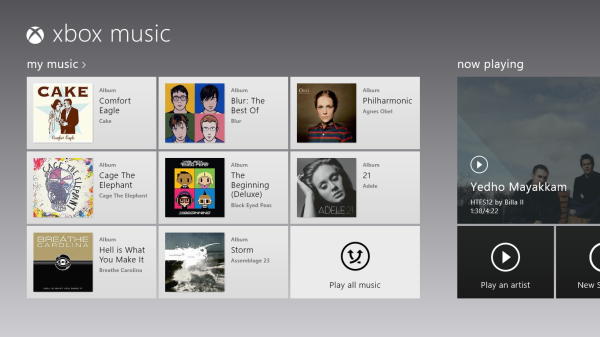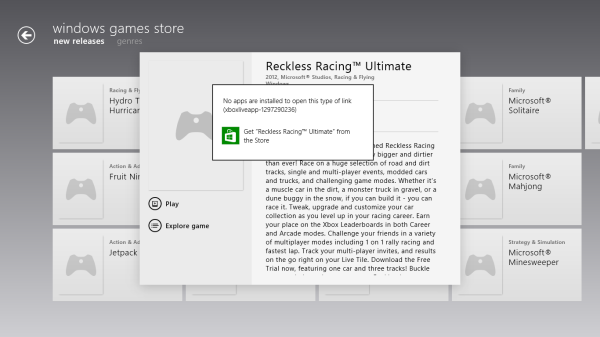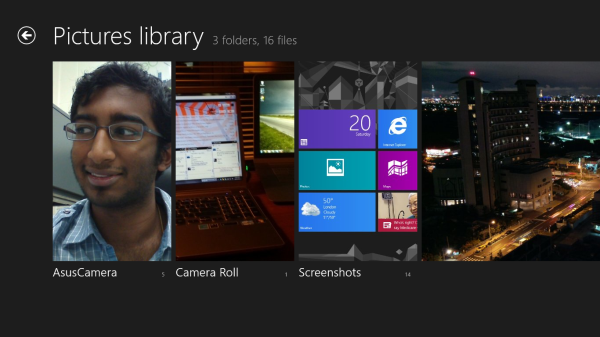The Windows RT Review
by Vivek Gowri & Anand Lal Shimpi on October 25, 2012 12:00 PM EST- Posted in
- Windows RT
- Operating Systems
- Microsoft
- Mobile
- Windows 8
- Tablets
Xbox Live: Music, Video, and Gaming
The music and video players are now part of the Xbox Live family of services, so they’re connected to Xbox Music and Xbox Video respectively. The applications are separate but are very similarly designed and laid out, with local content on the left, featured content in a central location, and content stores to the right. The bottom edge swipe brings up the ability to specify a file for playback, as well as a now-playing control bar. The music application looks quite good when snapped to the edge, with various album art from your library appearing as the background for the music controls.
Hilariously, videos can also be played back when snapped, albeit in a very small window. It’s not the best way to watch a video (who enjoys watching video content in a 320x180 window? Anyone? No takers?) but you can do it if you really want to. The video playback controls are pretty elegant in full-screen mode, and both players seem to have taken a number of interface design cues from the Zune software. I’m a huge fan of the Zune desktop software and how elegantly it operates, so I think this is great. I’m also just glad to not have to deal with Windows Media Player.
Both Xbox Music and Xbox Video look very similar to the latest Xbox dashboard update, and it’s clear that Microsoft is pushing a unified entertainment content front here. I remember when Microsoft was supporting a half dozen different music stores when the original Zune launched in 2006, so I’m just glad that they’re finally consolidating all of their services and concentrating on a single content store. Xbox has been their most successful entertainment effort to date, so it’s no surprise to see Microsoft put their faith in it for media as well.
Now, we can’t discuss Xbox without touching on gaming. Xbox Live is obviously the gaming portal of choice for Windows RT, and offers various hubs for Windows and Xbox 360 games. The Xbox Live application didn’t appear to be ready at the time of posting, with broken links and missing pictures for all the games and hubs. This is still an unreleased software (until Friday, anyways) so it’s possible that we’ll see the application be updated between now and then for a working final release. We will also have to wait until then to see what game support will be like out of the box; currently, the Xbox Windows Game store shows titles like Reckless Racing, Hydro Thunder Hurricane, Fruit Ninja, Cut the Rope, and a number of Microsoft classic titles like Minesweeper and Solitaire, amongst others.
Camera and Photos
The camera application is about as basic as you can get, with a translucent control bar that lets you switch cameras, change between still and video capture modes, set up a timer, and basic picture quality settings. Basic isn’t necessarily a bad thing though, as the application operates smoothly and quickly, with near-instant switching between modes and cameras. The controls are very straightforward - tap and hold to lock exposure is supported, and to capture an image you can just tap anywhere on the screen. It’s one of the easiest capture mechanisms out there, and fits right in with the simple UI.
The photo application pulls images from your local pictures folder and camera roll, as well as being able to connect to Facebook, Flickr, and SkyDrive. They show up as panels for each service, which show a full list of thumbnails. It’s worth pointing out that you can only see photos uploaded to Facebook from your own account, not friend’s images or pictures you’ve been tagged in. As is now the norm with tablet picture galleries, you can view images in slideshow form or just flick through them individually. For local images, the bottom edge swipe brings up an option to delete the images, as well as setting as the lockscreen image and starting a slideshow. For images on Facebook, there’s an option to view them in Facebook, though you need to actually be signed into Facebook in IE for this to work.
The overall takeaway from the camera and gallery applications is that they’re designed as minimally as possible and do exactly what they’re supposed to with a minimum of fuss. You won’t see any spectacular functionality, though the ability to slideshow through Facebook galleries is a nice touch. I think we’ll see manufacturers offer their own spin on these applications, like ASUS and their separate camera application, in an attempt to gain minor levels of platform differentiation. Microsoft has kept a pretty tight reign on the customizations allowed for the Windows Phone platform though, so I can’t see them allowing anything too invasive on Windows RT devices either.















233 Comments
View All Comments
aepxc - Thursday, October 25, 2012 - link
..."Tablets (despite being low power) are cannibalizing the PC market. Why is this?"...IMHO, because number of activities that can be done with a computer >> number of activities that can be done on a computer. I really think the consumption vs. creation framing is a misunderstanding – the thing actually being measured is how much of the creation is done on the computer (e.g. read an interesting article, form a new insight into a problem you have been trying to solve), and that is not, I believe, of significant importance.
But thanks for your response – it's an interesting perspective, well-argued.
ludikraut - Friday, October 26, 2012 - link
..."Tablets (despite being low power) are cannibalizing the PC market. Why is this?"...I'm not sure that tablets are cannibalizing PC sales. I think instead PC sales have remained stale as for several years now the hardware has been powerful enough for the average user to do just about anything they need on their computer. This means that instead of buying a new PC every two to three years, you've now got that money available to purchase something in addition to your existing and perfectly capable PC. More times than not that extra purchase will take the form of a tablet or e-reader these days, IMO. So in essence I think overpowered PCs are helping to drive tablet sales. :)
l8r)
twtech - Saturday, October 27, 2012 - link
I would tend to agree with that. I think they will have some impact on PC sales in the cases where the PC would have been bought solely for somebody to browse Facebook with.I have no interest in giving up my PC though, even as I type this post out on a Nexus 7. I use this thing mostly for web browsing and watching Netflix when I don't want to have to sit at a desk. My desktop PC does everything else.
steven75 - Friday, November 2, 2012 - link
The iPad has had a first party office suite since the first iPad was announced in 2010, along with third party word processors too numerous to count.What exactly is stopping you from taking notes in class on an iPad? Can't find a BT hardware keyboard out of the hundreds available?
I don't get this argument. At. All.
daboochmeister - Thursday, October 25, 2012 - link
You didn't point out that there are real limitations with the Office included in the Surface RT ... no macros/plug-ins, and you can't use it for any work-related tasks unless there's a separate license for Office 13 in place.http://office.microsoft.com/en-gb/home-and-student...
Notice that last comment - many reviewers are glossing over this - you need a license for Office 13, not a previous version, to use it for work tasks. If your company hasn't upgraded, you can't (legally) use it for anything for-profit.
Spivonious - Thursday, October 25, 2012 - link
Just like every version of Office Home and Student from 2007 on. This is not specific to Office 2013 on Windows RT.daboochmeister - Thursday, October 25, 2012 - link
But it has particular relevance here, because of the way the Surface RT has been viewed (and reviewed) as a business tablet ... but there's been little discussion of these limitations.For example, I haven't seen a single review point out that if your company has only licensed Office 2010, you don't have the necessary license to permit (legal) use. Do you, Spivonious? Has your company upgraded? Mine hasn't ... and our customer sites still use 2003, many of them.
And ... a key difference is that most business licenses permitted installation of the full suite on people's PCs at home -- eliminating the concern about macros/plug-ins/forms/3rd party apps. That's simply not possible here.
ssiu - Thursday, October 25, 2012 - link
Yeah the bundled Office RT gives no extra value for companies. That is because it is a "Home and Student" version. But that is no different than the "traditional x86 Office Home and Student" license -- you cannot use that for work either (even non-profit organizations), even if you buy it.(Whether people follow or ignore the license restriction is a separate issue ...)
daboochmeister - Thursday, October 25, 2012 - link
See my reply above for why there is a big difference in this case ... most business licenses permitted an employee to install a copy on a home PC, for business use. That simply won't be possible here.karasaj - Thursday, October 25, 2012 - link
Most businesses will probably go for Windows 8 or Windows 8 Pro (See Surface Pro). RT really honestly has simply been marketed for exactly that - home and student use.